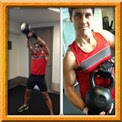In this video Body Life trainer, Heinrich Wolhüter, shares four
exercises you can complete for a high-intensity interval training (HIIT)
and Tabata workout.
Saturday, 19 March 2016
Saturday, 5 March 2016
Why You Only Think You're Doing HIITs But Probably Aren't (and Don't Really Need to Anyway)
This article is interesting and pinpoint the fact that many of people are actually not doing strict HIIT. However, some variations bring significant benefits too.
Extracts:
"The thing is, the term "HIIT" has been thrown about so much in recent years, it's true essence has become diluted. I was chatting with Fabio Comana, M.A., M.S., faculty instructor at San Diego State University, and University of California, San Diego at the IDEA World Fitness Conference where he was giving a lecture about this topic. He says, many of us out there think we're doing HIIT programs but we're really doing "some intensity" or "slightly higher intensity" intervals instead. This means we may not actually be getting all those amazing HIIT benefits we read about like increased V02 max and endurance, improved insulin sensitivity, reduced body fat and blood pressure and increased EPOC, excess post-exercise oxygen consumption (a.k.a. "afterburn"). Not to mention the well-touted benefit of saving time since HIIT workouts are supposed to be short and intense."
"What most of us are really doing, says Comana, are "HVIT" (High Volume Interval Training) or "VIIT" (Variable Intensity Interval Training) workouts. "High volume" meaning a lot of intervals or reps, not performed at maximal levels or, "variable intervals" meaning not all the intervals are done at same intensity or duration, nor are the recoveries. Is this a bad thing? Hell no!"
What are the key takeaways?
Extracts:
"The thing is, the term "HIIT" has been thrown about so much in recent years, it's true essence has become diluted. I was chatting with Fabio Comana, M.A., M.S., faculty instructor at San Diego State University, and University of California, San Diego at the IDEA World Fitness Conference where he was giving a lecture about this topic. He says, many of us out there think we're doing HIIT programs but we're really doing "some intensity" or "slightly higher intensity" intervals instead. This means we may not actually be getting all those amazing HIIT benefits we read about like increased V02 max and endurance, improved insulin sensitivity, reduced body fat and blood pressure and increased EPOC, excess post-exercise oxygen consumption (a.k.a. "afterburn"). Not to mention the well-touted benefit of saving time since HIIT workouts are supposed to be short and intense."
"What most of us are really doing, says Comana, are "HVIT" (High Volume Interval Training) or "VIIT" (Variable Intensity Interval Training) workouts. "High volume" meaning a lot of intervals or reps, not performed at maximal levels or, "variable intervals" meaning not all the intervals are done at same intensity or duration, nor are the recoveries. Is this a bad thing? Hell no!"
What are the key takeaways?
- That unless you're a competitive athlete, HIITs in their true form are probably not necessary.
- A sound, high volume or variable intensity interval program is a better fit for most. A knowledgeable trainer or instructor can make all the difference here.
- Newbies will hate life and likely drop out if they start off with Tabata or other type of HIIT training
Fittest Loser Workplace Tip: Tabata a short, powerful workout
Extract:
The timing is important for tabata training --
a high-intensity interval training workout where you go nuts for 20
seconds, take a 10 second rest and then repeat that cycle until you hit 4
minutes. To help you keep track, there are lots of timers and apps out
there, like Totally Tabata.
Do you think you can try it at the office?
"
Don't want to be a sweaty mess at work? You can also use the tabata method for strength training or an ab workout.
Here's one I like for triceps:
Exercise 1: Tricep dips (use stable chair or stairs at work)
Exercise 2: Leg extensions
Exercises 3: Chair or wall squats
Exercise 4: Leg extensions (sit in chair or on step and extend one leg at a time)
Do 20 seconds of each exercise, one at a time, followed by 10 seconds of rest until you hit 4 minutes."
Full article: link
Subscribe to:
Comments (Atom)




